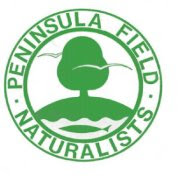With hopes of ticking Spruce Grouse, Gray Jay and Black-backed Woodpecker on our life list, Jean and I attended the
OFO field trip in
Algonquin Provincial Park on Saturday April 25.
I booked a vacation day on the Friday for a more relaxed drive to Huntsville, our home base for the weekend. Driving along Hwy. 11 we viewed a
Common Raven (#90 for the year list), soaring above, as we passed through the Bracebridge area. Earlier sightings of large black birds sitting in trees could not be confirmed as American Crow or Common Raven. You gotta love birding at 100 km/hr. We arrived mid-afternoon and were soon walking the main street of the downtown. We stopped at a statue honouring
Tom Thomson and the Tragically Hip song "Three Pistols" began playing in my head. His amazing artwork has the same effect.


For dinner we sat on the patio of The Cottage Water Front Grill under the watchful eye of some
Ring-billed Gulls. One would soon bless me (as well as our table and Jean's purse) with some luck for the day of birding in Algonquin.
Saturday morning we arrived at the West Gate of the provincial park and birded from the parking lot while waiting for the arrival of our field trip leader. In a tall pine, we all observed a nesting pair of
Merlin (#91), periodically leaving and returning to the nest, each announcing their arrival with a quick series of calls. Other birds observed at the West Gate, all in flight, included,
Barn Swallow (#92),
Northern Flicker and
Killdeer.
After a review of our planned itinerary and the birds we may encounter, approximately 75 birders in 31 cars (that's one huge carbon footprint) formed a long line (another song stuck in my head-Cake's "Long Line of Cars") en route to our first stop at kilometre 8.
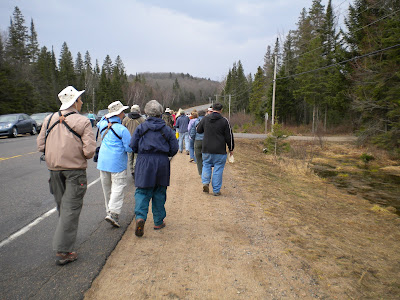
We were looking for Black-backed Woodpecker by the roadside, one of our target birds. We would find 4 species of woodpecker,
Northern Flicker,
Hairy,
Downy and
Yellow-bellied Sapsucker but no Black-backed while walking along the north shoulder of Highway 60.
Common Raven and
Herring Gull were seen in flight. Here's a tip. A gull sighted in Algonquin Provincial Park will almost always be a Herring Gull. No fast food joints = No Ring-billed Gulls we were informed by
Ron Tozer, our field trip leader, during the introduction at the West Gate. Yes, the Ring-bills are all at the waterfront eateries evacuating on patrons and birders!
We walked along Tea Lake Dam road for a brief period of time and with it being such a large group, arrived too late to hear the song of an Eastern Towhee, though both Jean and I did hear a White-throated Sparrow (#93). For my lists, if the bird has previously been ticked as a lifer, hearing its song without visual spotting it, counts. From the road, Jean and I would observe a Yellow-rumped Warbler (#94), our first warbler of the year and 2 Common Grackle before leaving for the next stop, kilometre 23. While travelling between kilometre 8 and 23, we spotted a Great Blue Heron (flying overhead), a Red-tailed Hawk (roosting in a tree) and a Mourning Dove on a power line.
We would stand on the south shoulder, overlooking Cache Lake, at kilometre 23 with many
Common Grackle and
Red-winged Blackbird flying between the trees and bullrushes.
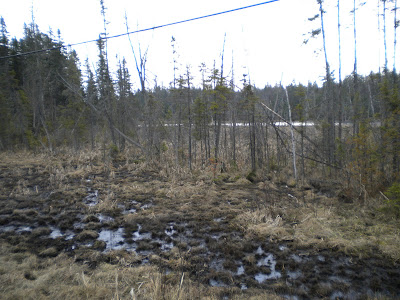
We would get some great views of 2
Wilson's Snipe (#95) in this area. Other birds observed included,
American Crow,
Tree Swallow,
Song Sparrow, and
Belted Kingfisher.

Ron Tozer: Field Trip Leader, 2009 Distinguished Ornithologist Award,
and author of "The Birds of Algonquin" (2011)
It was now close to 11:00 AM and the next stop was the Spruce Bog Boardwalk, in search of Spruce Grouse. We walked along the trail into the Black Spruce forest a short distance where Ron informed us of the plan to observe the bird we sought. Using a tape recorder he played the call of a female "Franklin's" Grouse, a western subspecies, to attract the attention of any eastern Spruce Grouse in the area. From the trail's register box, the group spread out, leaving the trail, soon to find one of the birds on the trip target list, a male Spruce Grouse, lifer #254 for Jean and I. We would study the bird for some time, with a show soon to come.

Ron's assistant on the trip, Kevin Clute, returned with a cardboard box. What was in the box you ask?
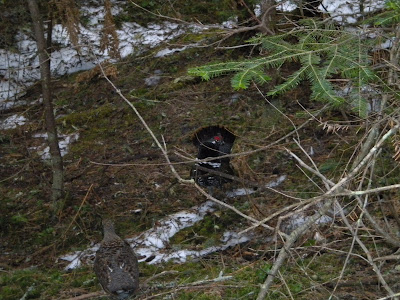
Ron revealed a mounted female of the "Franklin's" subspecies. The male almost immediately began its courtship display! We all had an excellent view and Jean captured some great images of the male spreading his tail, erecting his red eye combs and rapidly beating his wings.
 Note the orange fringe on the tail.
Note the orange fringe on the tail.
The males of the western subspecies have a tail that is all black.
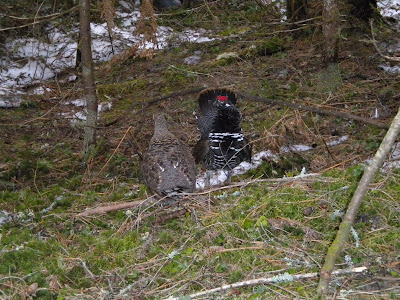
Hey baby! You come to this bog often?

Note the close proximity of Ron's boot.
Cameras flashed from all angles as if the bird was strutting on the red carpet like a Hollywood star, yet it was not stressed at all. It was totally captivated by the mounted specimen. Ron would eventually remove the specimen and Jean and I would spend some more time observing the lifer before heading to a female Spruce Grouse, found only 5-10 metres from the male. Had she rejected the male earlier? Though not as colourful as the male, the female was still an awesome sight. It walked in the undergrowth, where the forest meets the bog, oblivious to the humans observing it.
Surveying Sunday Creek Bog, Jean and I observed a pair of Ring-necked Duck (we missed the pair of Green-winged Teal).

We returned to the trail to cross the bog, in hopes of finding the next target species, a Gray Jay.
Unfortunately, we would not observe any Gray Jay while walking along the boardwalk through the forest of Black Spruce. A first in the 20 years of this trip. Due to climate change, their numbers in the park are 1/3 of what they were 25 years ago. At this time of year the birds are quite busy feeding their young.
Returning to the parking area, Maris Apse, a trip leader for the OFO, picked out 2 Boreal Chickadee in the trees bordering the road side. Jean and I would spot 1
Boreal Chickadee (#223 for the provincial list) with 3
Black-capped Chickadee in a Tamarack tree while sitting on a slope of a large ditch.
Our birding at the Spruce Bog Boardwalk concluded, we would stop for lunch at the nearby visitor centre. At the back of the visitor centre is a platform for the park visitors to view a wide expanse of the park, including the meandering Sunday Creek, to the south. There are some feeders below the platform and Jean and I observed the following species,
Red-breasted Nuthatch (#98),
Purple Finch (#99),
Pine Siskin,
American Goldfinch, and
Black-capped Chickadee. Near the feeders, at the south-west corner of the centre, we would spot our second lifer of the day and second species of grouse, the
Ruffed Grouse (#255). Other species observed during the hour break include,
Blue Jay,
Red-winged Blackbird,
Common Grackle,
Red-tailed Hawk, and
Canada Goose. We missed the Evening Grosbeaks that a few of the group saw near the centre's parking lot entrance.

We were finished our lunch and had a quick look over the OFO gear for sale. A fellow birder, Cheryl, who actually sat at our table during the 2008 convention banquet, purchased a denim OFO baseball cap to match her denim shirt. She began to work it in to look like that. Yes, another Hip song played in my head, "Fifty Mission Cap".
The next stop was Opeongo Road. The road winds north of the highway for 6.2 kilometres through bog, sedge marsh, and Black Spruce forest and ends at Lake Opeongo, a starting point for reaching interior camp sites by canoe. The weather was warm (21 degrees C) and sunny while travelling along Opeongo road. A pair of
Blue-winged Teal were viewed on Costello Creek from the roadside. An uncommon species for Algonquin Provincial Park. As we approached the end of the road in our car, Jean spotted
2 Common Loon (#101) on Lake Opeongo
. 1
American Crow and 1
Herring Gull were observed in flight while heading back to Highway 60.

We would continue east along the park corridor and stop between kilometres 53 & 54, slightly west of the Leaf Lake Ski Trail. The temperature was now at 23 degrees Celsius (I'm going somewhere with this). Along the north side of the highway is a utility line. Jean and I would soon see why Ron had stopped here. On a utility pole was a male Black-backed Woodpecker (lifer #256) excavating a nest cavity. Their backs are definitely black and the yellow head on this bird looked like it had been pollinating flowers. What a beauty! When a large group of vehicles has stopped by the roadside in Algonquin, it won't take long for another car to soon stop. A family stepped out of their car to investigate what the OFO group was viewing. The mom of the family asked Jean, "What are you looking at?". Jean replied, "A woodpecker". "Oh, we thought it was something good", stated the mom. Jean then informed the mom that it was a Black-backed Woodpecker and why we were so interested in it. She then thanked Jean and quickly left. I guess some park visitors are there only for the large mammals.

After turning around at the Logging Museum, we were now heading west on Highway 60. The next stop was West Lake Smith Pond. We had to walk through some fallen trees and avoid some moose dung along the way. On the pond we would observe
Bufflehead and
Ring-necked Duck, while
Turkey Vultures soared overhead and
Purple Finches played in the nearby tree tops. The temperature had now reached 24 degrees Celsius (I'm getting there).
The group's next stop was the Old Airfield, a spot Jean and I visited in June of last year. Along the way a heavy rain would fall, dropping the temperature to 14 degrees Celsius (my reasoning behind the earlier weather reports). Before reaching the Old Airfield Jean and I would stop for the very thing the mom and her family were most likely wishing to see. A large mammal in the form of a moose.
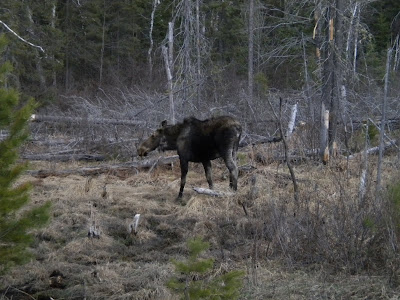
Last year we hiked along the dirt road during a guided walk with a park naturalist. But I guess being a retired naturalist Ron has connections and his assistant opened the gate to allow our cars through. We would drive the cars until we reached a spot overlooking Lake of Two Rivers. Spotting scopes were brought out, including ours, and some fine looking birds were spotted on the lake.
Bufflehead,
American Wigeon,
American Black Duck,
Common Merganser, Common Loon, and a
Red-necked Grebe (#103 for the year list) were observed. I never thought my first observation of Red-necked Grebe this year would have been in Algonquin. They are quite easy to tick in the Burlington/Oakville area (40 minutes from St. Catharines).
Song Sparrow and
Tree Swallow complete the list for birds seen at the Old Airfield. While we were there, a light rain fell, creating a thick mist that would slowly swallow the Common Loon.

Heavy rains occurred again and one more stop was planned if it settled. But unfortunately the rain continued as we reached kilometre 8, bringing an end to the 2009 OFO Algonquin Field Trip.
For Jean and I, the trip was very productive. 13 birds were added to the year list, 4 of which were added to the provincial list and 3 to the life list. We would celebrate the additions with dinner, still in our hiking gear, at "3 Guys and a Stove". As you're leaving Huntsville for Algonquin Park you pass the excellent restaurant. The food was amazing! The owner/chef made Jean a killer gin martini. Is there any other way to end a day of birding? The current rate for an accompanying photographer, 2 gin martinis. The addition of 3 lifers on an OFO trip, priceless. Many thanks to my wife Jean for the excellent images of our day in the field. Without them, the posting would have been meager indeed.
Sunday we would return to the provincial park for another day of birding. Anymore Boreal species found? Results to be posted soon.




